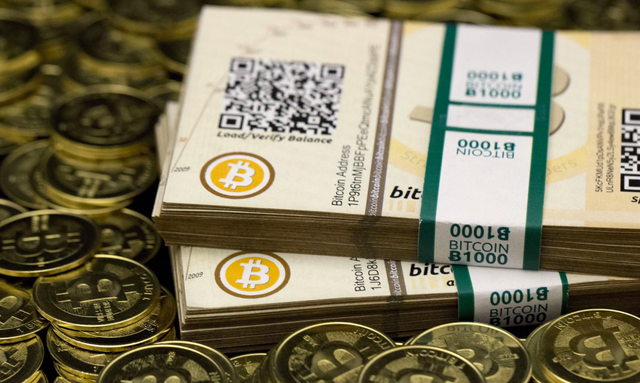Reality Check: It Doesn't Matter Whether Bitcoin "Exists" or Not #1

It’s time to put crypto currencies in perspective
Garet Garrett, editor of the New York Tribune, wrote in 1932: “Mass delusions are not rare. They salt the human story.” He had written the book “A Bubble that Broke the World” in response to the 1929 Wall Street crash.
In 2008, the world reeled at the effects of yet another mass delusion. For years, US banks had been dishing out home loans to eager Americans, bunching them together as mortgage-backed securities, and confidently rating them as “A” investment pools. In reality, they were nothing more than a conglomeration of poor credit ratings, regular defaults, and the fragile hopes of the American dream. The result was the bubble burst of the US housing market – an example of financial hubris that led to the worst global economic recession in history.
In late 2017, we witnessed our most recent mass illusion: the rise of cryptocurrencies, sweeping in on a tide of acceptance because this time, we were familiar with paradox, and comfortable with the tension between reality and unreality. Illusion doesn’t faze us. The enigmatic Satoshi Nakamoto’s 2008 paper "Bitcoin: A Peer-to-Peer Electronic Cash System", laid the groundwork for the anarchist’s dream of decentralized economics – no middle man, little to no transfer fees, and the immutable beauty of blockchain technology.
The messianic nature with which cryptocurrencies have been heralded is quite remarkable. The feverish belief, although waned by 2018’s market volatility, continues to this day. Is this just another illusion about to dissipate into the ether of economic bubbles, politics and stifling regulation? Perhaps it ought to, but in the face of reality, even this fantasy holds a chance.
Unblocking the chain
For many people, the illusory nature of cryptocurrencies is deeply suspect. While we might welcome the idea of recording land ownership rights on an immutable record, or validating insurance policy claims in unprecedented time, many cannot accept that their money – their personal store of wealth, their account of debt, and their medium of exchange – could exist in cyberspace devoid of any middleman whatsoever. At its core, blockchain technology is about creating trust in a trustless system.
The most vehement critics of the so-called “bitcoin bubble” invariably throw up the same question: “Is any of this actually real?”
In addition, how long can we realistically sustain a monetary system that runs on a technology that habitually gets hacked, leaves much to be desired in the way of regulation, and is beginning to look more and more centralized by the day?
Right now, cryptocurrencies face three major challenges:
How to scale, sustainably. Bitcoin can process an average of only seven transactions per second, compared to Visa’s 2000, with a peak capacity close to 50,000. Despite the improvements, concerns still linger, like the cost of mining Ethereum and Bitcoin, the top two cryptocurrencies at the time of writing. Hawaii is the most expensive US state in which to mine Bitcoin, where it can cost up to $9,483 per coin. If cryptocurrencies are ever going to rival fiat currency in a meaningful way, usability and sustainability will have to be addressed.
The threat of centralization. When Satoshi Nakamoto wrote his/her/their/its whitepaper in 2008, the underlying emphasis was on a decentralized monetary system that obviates the need for a middleman. But take a look at the state of cryptocurrencies today, and you will quickly see similarities with traditional monetary systems. The only difference is that banks and governments have now been substituted for exchanges, wallets, and online pump-and-dump-groups.
The need for regulation. Like it or not, cryptocurrencies have reached a point where regulation, in some form, is necessary. There have been at least 36 major heists on cryptocurrency exchanges since 2011, many of which later had to shut down. More than 980,000 bitcoins have been stolen, worth about $16 billion today.

Bitcoin price chart after the Mt. Gox hack
Governments are also likely to fret increasingly about lost tax revenues; of Coinbase’s 13.3 million users in 2017, only 802 recorded their crypto earnings to the IRS.
These concerns, along with the apparently illusory nature of cryptocurrencies, have given rise to much skepticism, with some predicting immanent collapse and a sharp descent into ruin for investors (take a look at Coin Market Cap on most bad days and you may share similar sentiments) The irony is that while critics carp and fret, they still want a piece of the pie. Fund manager Mike Novogratz calls cryptocurrencies “the biggest bubble of our lifetimes”, and yet he is starting a $500 million fund to invest in them. Jamie Dimon, CEO of JP Morgan Chase, calls bitcoin a “fraud”, yet his own bank is considering offering bitcoin futures to clients. This inconsistency reveals something important: where there is money to be made, market forces will create value where it would not otherwise exist.
Welcome to crypto economics. This is just the tip of the iceberg, but a good place to start is to understand the nature of money, and why hashes in cyberspace are no different from the paper in your purse.